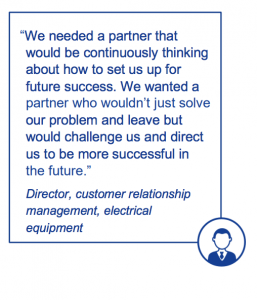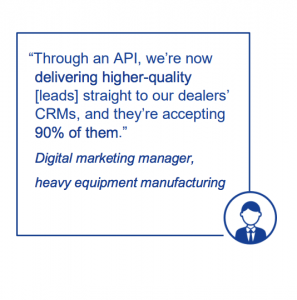More customer expectations. More data. More connected devices.
It’s all increasing rapidly, driving the need for digital transformation. But while most manufacturers acknowledge the importance of this transformation, over the past few years only 5% of executives have been happy with their current digital strategies (Forbes).
Why Manufacturing Is Different
The standard definition of digital transformation is simple: the process of using digital technologies to create new – or modify – business processes and customer experiences to meet changing demands. But how do you define digital transformation at your own organization? And why makes manufacturing so unique?
6 Challenges Featured in Forrester Study
“Manufacturers and distributors lag behind the consumer world by at least 10 to 12 years in being customer focused,” stated one vice president of product management quoted in The Total Economic Impact of Working with Perficient in the Manufacturing Industry, a commissioned study conducted by Forrester Consulting on behalf of Perficient.
Forrester Consulting found the average manufacturer experienced 114% ROI and benefits of $3.8 million over three years by working with Perficient. For the study, the firm interviewed executives in the manufacturing industry who are responsible for driving digital transformation and improving dealer and customer experiences.
The most common challenges:
 #1: Transforming a digital vision into a roadmap.
#1: Transforming a digital vision into a roadmap.
Finding or hiring people who know both the manufacturing industry and what’s needed to modernize processes is a growing challenge. According to one executive: “There weren’t a lot of people in my organization who could understand the vision of what we were trying to achieve – integrating data and connecting systems to truly develop a 360-degree view of everything.”
When it comes to turning a digital strategy into reality, working with a partner who’s been down the path before can help many manufacturers save time and money. But agility – and seeing the big picture – is also important. “We had our roadmap, but technology and priorities change as you start executing,” said one CRM director.
In other words: finding a partner who’ll adapt to your needs is critical, too.
#2: Overcoming organizational and technical barriers.
Most manufacturers agree with the value of digital transformation and improving CX – they just struggle to put it into practice at their own organizations.
As one executive shared: “We had four different homegrown CRMs that were working independently of one another. None were linked.” Another explained that some team members didn’t appreciate the value of a CRM system: “It was a free-for-all. People would create contact records and give them code names. Data was only providing value for the person who entered it. There was no accountability.”
There’s no doubt: with different systems and standards, connecting the dots can be a complex undertaking. But the results can dramatically improve onboarding, planning, dealer enablement, communication, marketing effectiveness and more.
#3: Using data to drive success.
For many manufacturers, manual processes and inadequate governance policies result in data that’s incomplete, duplicated or otherwise unhelpful.
Data can be your most valuable tool. And the cleaner it is, the better the outcomes will be for your organization. Case in point: by tracking and consolidating transactions across channels, manufacturers can better personalize customer interactions, which can increase cross-selling opportunities as well as overall lifetime value.
As another executive noted in the study: “When someone calls in, we should know more about our relationship with that customer than they do. Having that will help us provide a better experience, but also, we can take that knowledge and improve our products as well.”
#4: Dooming new projects to fail without the right expertise.
Without the expertise to deliver the proper analysis, architecture, and implementation, modern systems and projects can quickly fall short of expectations.
“Our marketing team was very passionate about using marketing automation, but we couldn’t accurately model the value out of the tool,” said one CRM director. “We could spend an awful lot of money on it, implement it, and then it wouldn’t really give the marketers what they expected. It would probably cause more harm than good.”
Remember, setting your organization up for success isn’t simply about determining what tools you need – it’s about why and how they should work together.
#5: Coordinating with dealers to pursue leads.  Dealers, distributors, and partners are no different from your sales team when it comes to leads. They expect them to be well-qualified and quickly ignore them if the lead quality falls short.
Dealers, distributors, and partners are no different from your sales team when it comes to leads. They expect them to be well-qualified and quickly ignore them if the lead quality falls short.
“[Before working with Perficient], we’d send 100% of leads to our dealers, but dealers, who had grown to not trust them, weren’t calling or qualifying the leads,” noted a digital marketing manager at a heavy equipment manufacturing company. “Using this new process and technology, we went from a 2% win rate to about 16%.”
Bottom line: delivering high-quality leads typically results in higher sales – and more efficient processes, too.
#6: Improving dealer relationships to drive business outcomes.
Most manufacturing executives rely heavily on dealers for data access and sales, creating a unique set of challenges. “We tend to leverage partners more than internal resources. Because of that, it creates a natural gap in the data we need,” stated one director. “We can’t force our partners to provide us with probability and opportunity data.”
Without tools to better manage a dealer ecosystem and the revenue from it, many manufacturers struggle to keep both dealers and customers satisfied. But by implementing foundational solutions like streamlined lead management and self-service communities, manufacturers can better address those needs – which, in turn, will strengthen relationships and increase sales.
Learn More: Inside the Study
To learn more, download the complete study below, featuring a deep analysis of the savings, costs, and results of Perficient’s partner relationship management (PRM) solution. Or have any questions? Contact us anytime. Our experts will be happy to help!

